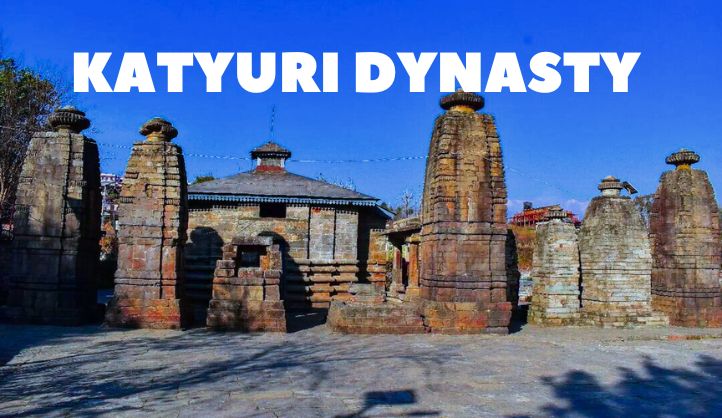Uttarakhand has a rich history. Among all its threads, the Katyuri dynasty shines brightly, leaving behind a legacy of art, architecture, and valiant rule. This blog delves into the fascinating story of the Katyuris, exploring their origins, reign, and enduring impact on the region.
Unveiling the Katyuri Kings – Origins and Early Reign
The exact origins of the Katyuri dynasty remain shrouded in some mystery. Some historians believe they hailed from the Katyur region of present-day Himachal Pradesh, migrating to Uttarakhand around the 8th century AD. Others trace their roots to Ayodhya or even the ancient Kuninda tribe.
King Vasudev Katyuri, sometimes referred to as Basu Dev, is credited as the founder of the Katyuri dynasty. His reign, estimated between 850 and 870 CE, laid the foundation for the Katyuri kingdom. Initially named Jyotiryana, the kingdom flourished with its capital established at Joshimath, nestled in the Alaknanda Valley. Interestingly, Vasudev is believed to have been a Buddhist ruler who later embraced Hinduism, possibly influenced by the renowned philosopher Adi Shankara.
Shifting Capitals and Expanding Horizons
The Katyuri dynasty witnessed a period of expansion and strategic capital shifts. From Joshimath, the seat of power moved to Baijnath, near the present-day town of Bageshwar. This shift, likely under King Brahma Dev, marked the beginning of a glorious era. The kingdom, now referred to as Kurmanchal (land of Kurma, the second avatar of Vishnu), encompassed a vast area stretching from eastern Himachal Pradesh to western Nepal.
The Katyuri kings were not only skilled administrators but also fierce warriors. They successfully defended their territory against formidable opponents like the Gahadavala and the Chandelas, further solidifying their reign.
A Golden Age of Art and Architecture
The Katyuri period they witnessed a flourishing of art and architecture that continues to inspire awe today. The Katyuri kings were patrons of the arts, commissioning magnificent temples and sculptures that stand as testaments to their devotion and artistic vision. Here are some captivating examples:
- Baijnath Temple: This exquisitely carved temple, dedicated to Lord Shiva, is a masterpiece of Katyuri architecture. Its intricate shikhara (tower) and detailed sculptures showcase the artistry of the era.
- Jageshwar Temple Complex: Nestled amidst a cluster of 124 shrines, the main Jageshwar temple exemplifies the Katyuri style. Its pyramidal shikhara and meticulously crafted idols offer a glimpse into the artistic sensibilities of the time.
- Katarmal Sun Temple: Dedicated to Surya, the Sun God, Katarmal Sun Temple boasts a unique architectural style and is believed to be one of the oldest Sun temples in India.
These are just a few examples of the architectural legacy left behind by the Katyuris. Their temples, often built using a combination of wood and stone, incorporated the Nagara style, characterized by curvilinear towers and intricate ornamentation.
The Twilight of the Dynasty
The Katyuri dynasty’s reign saw its peak around the 12th century AD. However, the subsequent centuries were marked by internal conflicts and external threats. The rise of the Chandellas and the eventual invasion by the Gahadavala in the 12th century weakened the Katyuri hold. The kingdom eventually fragmented, with smaller principalities emerging in its place.
The Enduring Legacy of the Katyuris
Despite its eventual decline, the Katyuri dynasty’s influence on Uttarakhand remains undeniable. Their architectural marvels continue to attract visitors and scholars. Additionally, the Katyuri period laid the foundation for the development of the Kumaon region, shaping its cultural and administrative landscape.
Beyond the grand temples, here are some enduring aspects of the Katyuri legacy:
- Promotion of Hinduism: The Katyuri kings played a crucial role in the spread of Hinduism in the region. Their patronage of Shiva temples and their adoption of Hindu practices helped solidify the religion’s influence.
- Development of Administration: The Katyuri dynasty established a well-organized administrative system, dividing their kingdom into smaller units for efficient governance.
- Preservation of Sanskrit: Sanskrit flourished under the Katyuri rule, with many literary works and inscriptions composed in this language.
The Katyuri dynasty’s story is an intriguing chapter in Uttarakhand’s history. From their rise to their eventual decline, they left behind a rich tapestry of art, architecture, and cultural influence.
FAQs About the Katyuri Dynasty
1. When did the Katyuri dynasty rule?
The Katyuri dynasty ruled over parts of Uttarakhand and western Nepal from roughly the 8th to 12th centuries AD.
2. Who was the founder of the Katyuri dynasty?
King Vasudev is considered the founder of the Katyuri dynasty, although the exact dates of his reign vary depending on historical sources. Estimates place it between 850 and 870 CE.
3. What was the capital of the Katyuri kingdom?
The capital of the Katyuri kingdom shifted throughout their reign. Initially, it was established at Joshimath but later moved to Baijnath near Bageshwar.
4. What are some of the architectural styles associated with the Katyuris?
The Katyuris primarily employed the Nagara style of temple architecture. This style is characterized by curvilinear towers (shikharas) and intricate carvings on pillars and walls.
5. What factors led to the decline of the Katyuri dynasty?
Several factors contributed to the decline of the Katyuris, including internal conflicts, external threats from rival dynasties like the Chandelas and Gahdwalas, and the eventual fragmentation of the kingdom.





